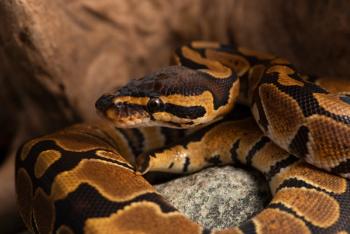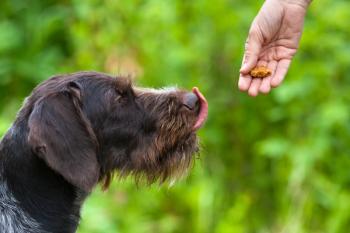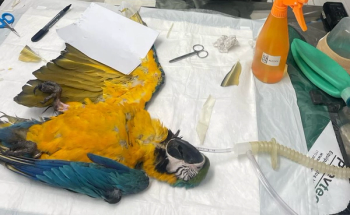
Approach to the anorectic reptile (Proceedings)
There is no question that the most common health problems associated with captive reptiles are diet related.
There is no question that the most common health problems associated with captive reptiles are diet related. These can be from nutritional deficiencies, such as is so commonly seen in the Green Iguana, excessive calorie consumption, as in overweight animals, or the most common problem, anorexia, or a lack of appetite.
The single most important factor to point out is that anorexia is a symptom, not a disease. There are numerous causes for a reptile to lose its appetite. These underlying causes must be identified and corrected before the problem will be resolved.
That is, when an animal is "off-food" there has to be a reason for it. It may be psychological, or it may be medical. Although this may seem elementary to most readers, it bears mentioning. It is essential that the veterinarian understands the natural history and biology of the particular type of reptile that they are treating. If they do not know, they must have a ready reference source. If one is not available, then, ethically, they should refer it to someone that has the proper training.
There are very few animals whose dietary requirements are completely understood. This small group includes common domesticated animals such as the dog, the horse and the cat. However, research continues daily and scientists are still finding out new and critically important information. For instance, as recently as just a few years ago, the connection between cardiomyopathy and taurine was discovered
The further you get away from domestication (and reptiles and amphibians are probably just about as far away as you can get) the harder it is to match a captive animal's free-ranging diet.
Take the common fence lizard for an example. It is housed in an old aquarium. A 100 watt lamp is used for basking and heat. The owner throws in a few pieces of old wood (how natural), and then tosses in a handful of crickets that were purchased at the local pet store. Since the owner is a member of a herpetological society and is into state of the art husbandry/care, the crickets are dusted with a vitamin D3 supplement to be extra sure that the right nutrition is being provided. A little shaved cuttlebone is added to the vitamin dust to ensure that the calcium:phosphorus ratio is at least 2-2.5:1. How can this lizard not do well?
Well, hold on for a moment. Let's analyze what just happened. First of all, where does it say that crickets are the right food item for the lizard? This animal is an insectivore, and therefore, it must eat crickets (that is the common logic so prevalent in pet stores).
Think about it for a moment using this analogy: A person is driving along and suddenly finds themself feeling hungry? They might be craving a Big Mac, but they don't pass by any Golden Arches, so out of desperation they settle for a Whopper.
Think of the lizard and the crickets again. When a person is hungry, at least they get to have the Whopper their way. If they don't want mustard or tomatoes, they can leave them off. If they don't want more calcium on their burger, they can tell the kid behind the counter in the little crown to hold the cuttlebone.
The lizard in the cage doesn't have the option of choice; it's hungry, so it eats whatever it is fed.
Nobody knows exactly what a proper diet is for a reptile or an amphibian. All we can do is extrapolate from our knowledge based on the few well quantified species of mammals. For instance, we know that dogs and cats need vitamins and minerals, therefore we assume that reptiles and amphibians do as well. But, how much?
It is a known fact that over-feeding of the mineral calcium, and the vitamin D3, and exuberant use of UV lighting can cause soft-tissue mineralization in iguanas, turning the lizard into a rock. People always ask how much vitamin/mineral supplement to use. Nobody knows the correct answer. If anyone states exactly how much to use, don't believe them. Definitely don't buy any land from them.
Let's get back to our lizard friend. We feed crickets because everybody else feeds their lizards crickets. For the most part, they are inexpensive and convenient to obtain, and, they look sort of like grasshoppers (?).
Probably the best way to determine what an animal naturally eats is to follow a group of that species around for years and record their entire diet. If you did this you would have an excellent understanding of the animal's natural diet, and, you would then have a very well fed pet. Not only that, you would probably win the Nobel prize for Herpetology (if there was one).
The next best way to determine what an animal eats in the free-ranging state is to trap and kill a number of that species, dissect them, and examine their stomach contents. I really don't recommend that this is done! However, for the serious interested herpetologist, this has been done for many species and the information is available.
For those of you that don't have the time or desire to go through the trouble of doing library research, this information is also available in an abbreviated form. There are many books available from local pet stores that cover this topic in brief detail. A word of caution: be certain to select those books based on scientific research as many are based upon anecdotal or empirical knowledge and not scientific fact.
This same reasoning can be applied to all species of reptiles and amphibians. Most pet stores and hobbiests feel that they are feeding proper diets. It is worth evaluating some of the common misconceptions:
"I feed my gopher snake mice, Doc. It is impossible to go wrong with a whole animal diet."
Well, this is true for the most part. Probably the best diet for a captive carnivorous reptile or amphibian is a whole animal diet. This however, also has many inherent dangers. This most obvious is the omnipresent calcium:phosphorous ratio. People with little reptiles (these are usually little because they are young and growing and need extra calcium in their diet because it helps build strong bones in twelve ways) have a tendency to feed them little mice (usually called pinkies or fuzzies).
This makes sense since little growing reptiles have little mouths and cannot physically eat bigger prey items. But, these little prey items such as pinkies or fuzzies are still growing themselves. They have not as yet developed a mature skeleton, and thus may be deficient in calcium. A one and one-half gram baby mouse has a calcium:phosphorus ratio which is just a little better than 1:1. Although we don't know for sure exactly what a baby reptile needs, a ratio of 1.5-2:1 would probably be more appropriate, especially for an animal experiencing growth.
In addition, it is a common practice for pet stores to buy pinkies by the dozen from clients. They then place the pinkies in a container and leave them there until they are all sold. Unfortunately, these pinkies, which are too young to eat or drink on their own, are usually dehydrated and have completely voided their ingesta by the time they are bought, taken home, and fed to the intended pet. That means that whatever food that was in their gastrointestinal tract (eg. milk - a source of calcium) is no longer present.
On this pinky diet the young growing reptile starts out life with an improper calcium:phosphorous ratio, and is constantly struggling to catch up. This is how people end up with pets that have curved backs, "S" shaped or broken legs, and turtles with funny shells.
There are many other, more subtle differences which should be considered. Again, back to the Burger King theory, a hungry snake eats the domestic pet store mouse because that is what it is offered. However, in the wild it may prefer other species of mice, such as a field mouse, a deer mouse, or a kangaroo mouse, etc. How many readers have fooled snakes into eating mice by "sliming" a mouse with a frog or "scenting" one with a dead lizard? What kind of subtle nutritional deficiencies/imbalances are we causing when we feed a frog-eating snake a disguised mouse?
Here is another subtlety that needs to be considered. Most pet store mice are fed a standard diet, one which is usually designed for laboratory mice. These laboratory mice are not designed as food items. They obviously don't eat the same as their wild counterparts, and as such the pet store mouse's intestinal contents won't be the same as its wild-counterpart. Not only that, but this represents the best scenario. A more common practice is to feed the rodents a less expensive food, such as generic dog food. This changes their nutritional worth even more. The captive mice, due to improper diet and lack of exercise, will have a tendency to be fatter than wild mice. This extra fat, and the difference in intestinal nutrients may not be ideal for the captive reptile.
It is easy to see how these subtle differences can potentially affect the captive pet's diet. Just these few items can have a profound effect on an animal's appetite as well.
Aside from offering improper diets, husbandry deficiencies can be a major factor in failure of a reptile to eat. Housing a reptile too cold is by far the most common cause for anorexia. Every reptile has a given temperature range where they confine the majority of their activity. It is within this range that they carry out certain key functions such as hunt, eat, digest and reproduce. If the animal is too cold it will not forage well, it may eat, but if it does, it will not digest properly. In some instances, if the reptile eats, and then gets too cold, it may regurgitate.
If the husbandry problems have been evaluated and corrected, and the patient still isn't eating as it should, then it is time to rule out medical causes of anorexia. A standard data base is the best place to start. Aside from the all important physical examination, a complete blood analysis, including CBC and plasma chemistries, radiographs, fecal analysis for parasites and if deemed necessary, appropriate microbiological testing should be performed.
If all the pertinent factors are considered, evaluated and the problems corrected, and the patient still is not eating, it may be time to try some more aggressive therapies. Some reptiles, especially those which are wild-caught, will experience something called "maladaptation syndrome." In this situation the animal is physically healthy but it still refuses to eat in captivity. This is believed to be due to chronic stress. These animal's will literally starve themselves to death if they do not obtain some type of calorie replacement.
Chronic starvation has severe consequences. The metabolic changes are well documented in mammals, and the effects of the condition are well noted in reptiles, although it is not known if the pathways are the same. In mammals, there is protein catabolism. This may be more of a factor in reptiles due to the production of excess uric acid, predisposing the patient to gout. Fat is mobilized for energy and there is a loss of fat soluble vitamins. Potassium is depleted leading to muscle weakness, gastrointestinal and skeletal changes. The intestinal villi atrophy which leads to malabsorption in the event food is taken in.
An off-feed patient should only be force-fed if the cause for the anorexia can not be determined, or if the cause can be determined but the animal is too weak to eat on its own. Remember, that anorexia is a symptom, not a disease!
Prior to attempting to force feed any ill reptile, it is imperative that the patient be stabilized. Careful attention to deficiencies (temperature, humidity, caging, etc.) is necessary prior to initiating any supportive care. Rehydration, including attention to replacement of fluids and electrolytes, is mandatory.
It is important not to overfeed a patient that has been anorectic for prolonged periods. In mammals, excessive calories can result in life-threatening hypokalemia and hypophosphatemia. Patients in good condition may receive 75-100% of their nutritional requirements over the first 24 - 48 hours. Patients in critical condition should be administered only 40 - 75% of their daily energy requirements in order to prevent digestive and metabolic disturbances.
Force feeding can be a very stressful event, especially when trying to force feed a whole animal prey item. It is not uncommon for the force fed animal to regurgitate its food shortly after the force feeding. This causes additional undue stress and further loss of body fluids and electrolytes. Sedating the reptile prior to attempting to force feed it (whole prey) may help reduce these complications by minimizing struggling and reducing the stress associated with the event.
There is debate whether or not to force feed with whole prey, minced prey or supplements. Each case should warrant individual consideration. Each type of supplemental feeding has its advantages and disadvantages.
An easy rule out for selection of force feeding supplements are the gel and pastes commonly used for calorie supplements in mammals. These preparations, which usually come in tubes, often are high in fat and low in protein.
For herbivores, it is easy to supplemental feed using vegetable gruels. Many diets have been recommended for this, depending on many different factors. The simpliest is a blend consisting of One banana, one can of Ensure and one multivitimin (containing D3). The slurry is then administered to the patient at one to three percent of its body weight, per day. This mixture is inexpensive, palatable and readily syringeable.
For carnivores there are more options. Whole prey are perhaps the most balanced food items. However, they are also the most difficult to present. A blended mouse mixture is acceptable, but it requires mincing and blending whole animals. Canned foods, such as dog and cat food, can also be used. However, when deciding on which to use, it is best to pick a high quality source, and preferable a feline product. These have a higher, more digestible protein source and are usually lower in fat than the dog diets.
If a whole prey is to be force fed, sedating the patient generally helps reduces the stress of the event and provides for a more successful outcome. Telazol (Fort Dodge Laboratories, Fort Dodge, IA) at 5 mg/kg, IM will relax the animal and facilitate the force feeding. The patient is usually sedated in about fifteen minutes, and will subsequently recover in a few to several hours. This has been a safe practice in the author's experience.
When selecting a whole prey item to be force fed, it should be of appropriate size for the patient. Prior to force feeding the prey item is euthanized and covered with vegetable oil. It is grasped with a long curved forcep and then introduced, nose first, into the mouth of the patient and gently directed down the esophagus.
After the force feeding has been completed the patient is allowed to rest quietly in a secluded cage, which has been pre-warmed to an appropriate temperature for the species, for a few days to allow proper digestion. A second force feeding attempt should not be attempted until after the current meal has passed. It may be necessary to repeat this technique a few times before the patient gains enough strength to eat on its own.
In some of the turtle species it may be impossible to force feed the patient, either because of a danger of being bitten, or because the animal may be too strong to extract its head and neck. In these patients the placement of a pharyngostomy tube greatly adds to the overall chance of a favorable recovery.
These tubes are may of soft rubber, and are placed through the skin on the side of the neck, into the throat and fed down into the stomach. This type of tube placement allows the patient to eat when it is feeling stronger. After the reptile's appetite has returned the tube is easily removed.
It is important not to cut corners when attempting to correct appetite problems. Always thoroughly evaluate the husbandry and management practices. If all is in order, and the patient is still not eating, then a thorough medical examination is in order. Quick fixes seldom work, and may delay vitally important care.
There are numerous products currently marketed in most reptile pet stores that are specifically intended to stimulate appetite. The problem here is that these "cure-alls" are aimed at getting the patient to eat without regard for the cause. I have yet to see value in any of these elixirs. For the most part all they contain are some vitamins and artificial coloring.
Remember, anorexia is a symptom, not a disease!
Newsletter
From exam room tips to practice management insights, get trusted veterinary news delivered straight to your inbox—subscribe to dvm360.






